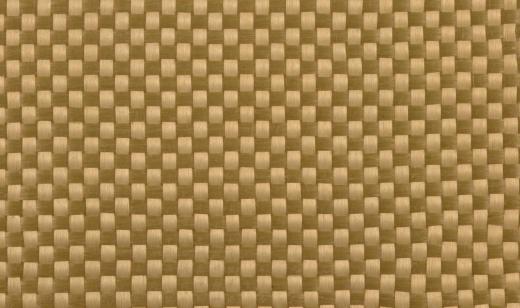What is Kevlar®?
 Tricia Christensen
Tricia Christensen
Kevlar® is an extremely strong material that derives its strength from its spider web-like weave. Stephanie Kwolek and Herbert Blades created this special material in 1965 for the Dupont Company. Since then it has been used in a number of ways.
To make Kevlar®, a special weaving method — known as an aramid weave — is used to turn a liquid into a solid. Aramid fibers tend to be difficult to corrode, resistant to heat, and have no melting point. Chlorine can degrade the material, however.
Because Kevlar® is light, it is the premium choice for bulletproof vests. A variant called Nomex® is fireproof and may be used by fireman or other people responding to disaster situations.

Different types of weaves that can be used to create this material, and the one that makes a fabric-like produce suitable for vests is called Kevlar® 29. This version may also be used in brake pads, or to replace asbestos. It is also is a major part of the composition of body armor.
There are two other main weave types: Kevlar® and Kevlar® 49. The regular, non-numbered version may be used to replace rubber items like tires. Type 49 is extremely strong and can replace the more traditional materials used for a boat hull, or be used in simple items like bicycle frames.

One of the most interesting applications of this material is its use in shelters for protection against tornadoes. The shed-like structures can be placed in a garage. Tests show it can deflect large projectiles at speeds of up to 250 mph (402.32 kph). In areas with frequent tornadoes, these shelters may become the best way to protect people from tornadoes.

Under great compression, Kevlar® can buckle, and in some cases, be pierced. After vest made of the material were introduced, for example, people quickly found a way to make bullets that could go through them. These are illegal for sale to consumers, but some armies use them to provide additional strength in ground combat.
In general, however, Kevlar® can be used in many ways to provide protection and for replacement of materials more likely to corrode. It's likely that even more products will be made from it in the futurein the future.
AS FEATURED ON:
AS FEATURED ON:















Discussion Comments
Does anyone know anything about the uses of Kevlar in communications satellites? Any information would be really appreciated! Also the toughness and flexibility (so fracture energy and young's modulus) would be really useful. I know some people have already posted some figures for the Young's Modulus [Young's modulus: 117 - 130 Gpa and
Young's Modulus is 76 GDA] but any confirmation would be great. Thanks!
Can somebody tell me the elements in Kevlar?
I'm doing a report in Chemistry on Kevlar and need to know how it could be developed in the future - any ideas?
Can I make a gimp suit out of kevlar?
I want to make a Batman costume. Should I use kevlar?
Kevlar on ebay is about £25 per square meter.
What is the impact of kevlar on the environment?
What are some interesting facts about kevlar?
i have a science project and i need to know if you could bend kevlar and use it for shinguards.
Can you buy Kevlar in a sheet, like you would buy a sheet of aluminum? What kind of properties does it have? Is rigid, or is it flexible?
What's the weight of kevlar 29 per square foot?
how could we get hold of just the kevlar material in the uk?
is kevlar made of anything dangerous?
does anyone knows the danger of kevlar. is it good for your health?
can kevlar mesh sheets be made to be hydrophilic?
Could anyone tell me the stress and strain of Kevlar 29? Please! Thanks.
DuPont Kevlar 29 Aramid Fiber, 12micron diameter
Price: 21.8 - 36.4 GBP/kg
Thermal conductivity: 0.2 - 0.3 W/m.K
Young's modulus: 62 - 80 GPa
Kevlar 49
Price: 49.4 - 139 GBP/kg
Thermal conductivity: 0.2 - 0.3 W/m.K
Young's modulus: 117 - 130 GPa
Kevlar 149
Price: 62.9 - 157 GBP/kg
Thermal conductivity: 0.2 - 0.4 W/m.K
Young's modulus: 170 - 190 GPa
Could you please give me more basic information about kevlar and how it is used with tennis rackets? thank you.
I am also doing a project on Kevlar for DT. we are doing Smart Materials, so any more info on the technology side of it?
does anyone know if kevlar is very resistant against wear from sandpaper? if not, is it stronger against wear than leather or some kind of fabric? thanks
how does the manufacture or use of Kevlar affect the environment or economy
well maybe the reason kevlar can conduct electricity is because it contains metalloids?
Kevlar has no metals so i imagine its conductivity is rubbish. It's youngs Modlules is 76 GDA.
hi, doing a project on kevlar, anyone got more information? mostly on the scientific side?
do they use kevlar on baseball helmets since I doing a project on it and it states that kevlar is used on helmets but are they used on baseball helmets
I wanted to know some more information about kevlar because im doing a project about it in physics,
i wondered if anyone knows the:
conductivity
Cost
and Young modulus of kevlar
Post your comments